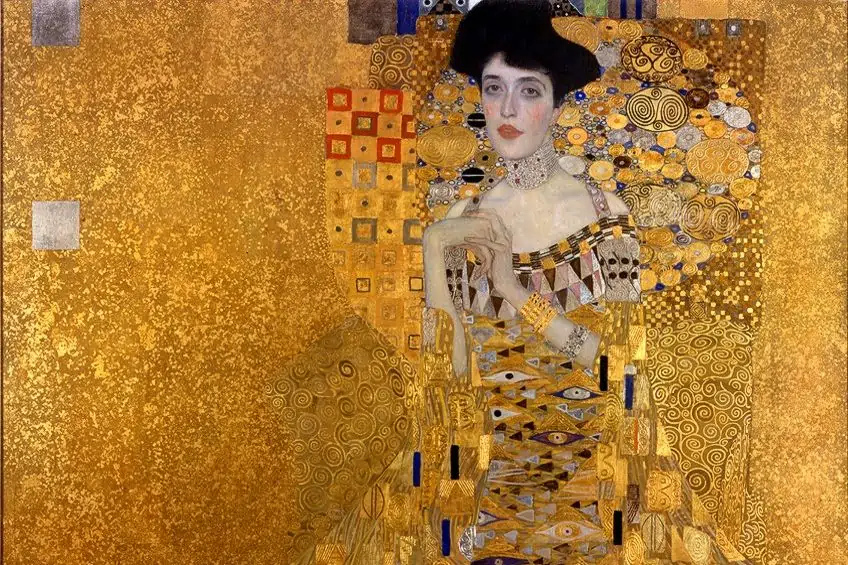Famous Portrait Paintings – A Look at the Most Famous Art Portraits
Portrait painting is among the most prevalent painting genres. In theory, it allows for a realistic picture of an individual while emphasizing their physical attributes and, maybe, spiritual or intellectual traits. This genre, characterized by portraits of individuals, has been performed by some of art history’s most significant artists, resulting in a large collection of famous portrait paintings. Whereas the famous portrait artists behind these works are well-known, the sitters are frequently obscure. In this article, we will take a look at our favorite famous portraits, and the artists and subjects that were involved in their creation.
Famous Art Portraits
Portraiture painting is usually regarded as the most challenging kind of painting since it necessitates a strong understanding of depicting the human figure in precise detail. Portraits are centered on one or more individuals, with the top region of the body receiving the greatest attention.
Some of history’s greatest famous artists were able to convey the core of human feeling in a single picture.
Many painters have analyzed human anatomy in-depth, attempting to grasp the intricacies in each small shift in expression. Famous portrait artists from all over the world, including Rembrandt and Leonardo da Vinci, have developed their painting talents in an effort to master the art of portraiture. Here is the list of our favorite famous portrait paintings.
The Arnolfini Portrait (1434) by Jan van Eyck
| Date Completed | 1434 |
| Medium | Oil Painting |
| Dimensions | 82 cm x 60 cm |
| Current Location | The National Gallery |
Jan van Eyck, who was born in what is now Belgium, was a pioneering exponent of the oil technique, using it to create carefully detailed compositions. His most famous work, The Arnolfini Portrait, is considered an emblem of the Northern Renaissance.
This is because it is said to encompass many of the period’s artistic ideals and technological achievements.
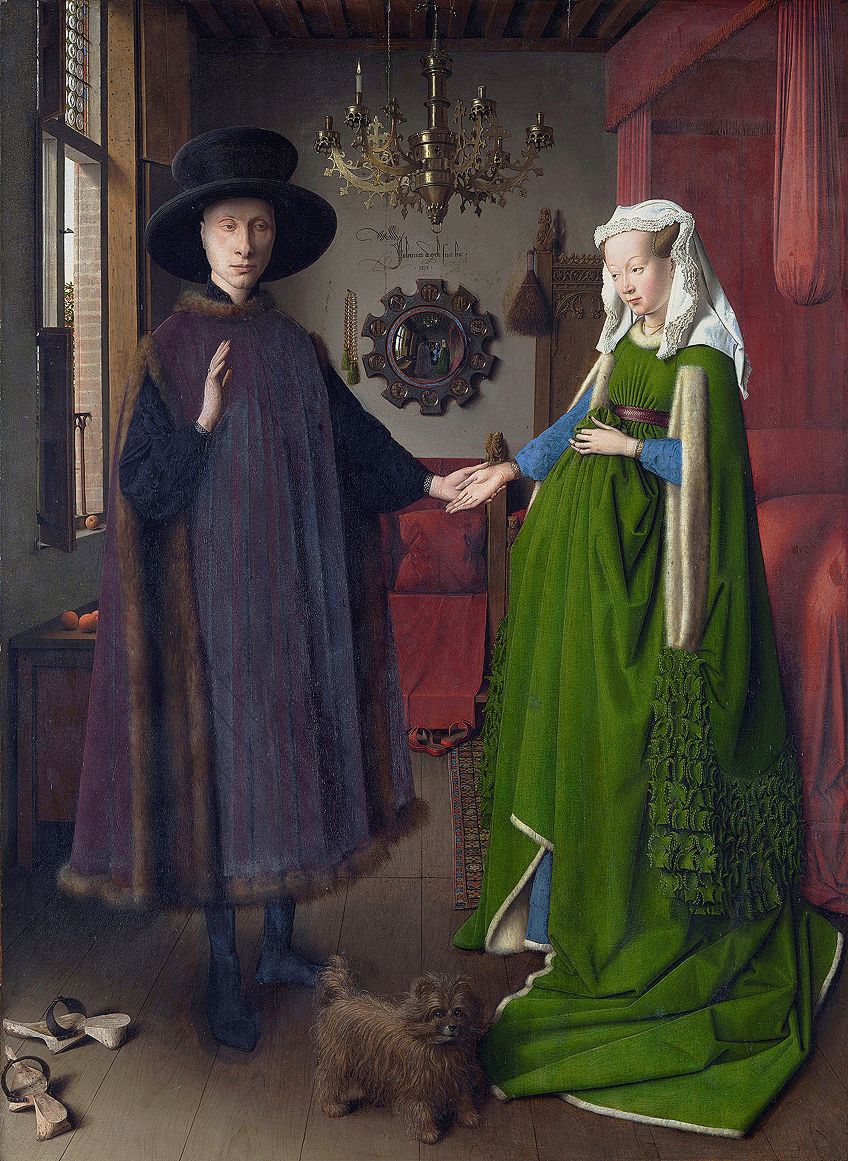
It represents a wealthy businessman and his wife, assumed to be Giovanni di Nicolau di Arnolfini, in a beautifully adorned chamber that displays their extravagant fortune. Since only single girls wore their hair loose in the 15th century, the female’s headwear implies a married couple. However, contrary to popular belief, the woman is not pregnant and is just clutching her billowing overdress at her chest, as was typical at the time.
The painting’s mystery, as well as Van Eyck’s amazing technique, continue to captivate spectators far beyond its 7th century of existence!
The Mona Lisa (1503) by Leonardo da Vinci
| Date Completed | 1503 |
| Medium | Oil on Panel |
| Dimensions | 77 cm x 53 cm |
| Current Location | Louvre Museum |
The Mona Lisa is one of the most renowned and famous portraits of all time, and it is without a doubt Leonardo da Vinci’s most prominent work in the portraiture category. The portrait, also identified as the Portrait of Lisa Gherardini, was painted in Florence, Italy, between the period from 1503 until 1519. The picture was painted in oil on wood paneling by Da Vinci and is well known for its exceptional level of precision as well as the sitter’s unusual stance.
Many art experts and aficionados are intrigued by the woman’s identity, and her eyes appear to have an extraordinary capacity to follow the observer, regardless of where they are situated.
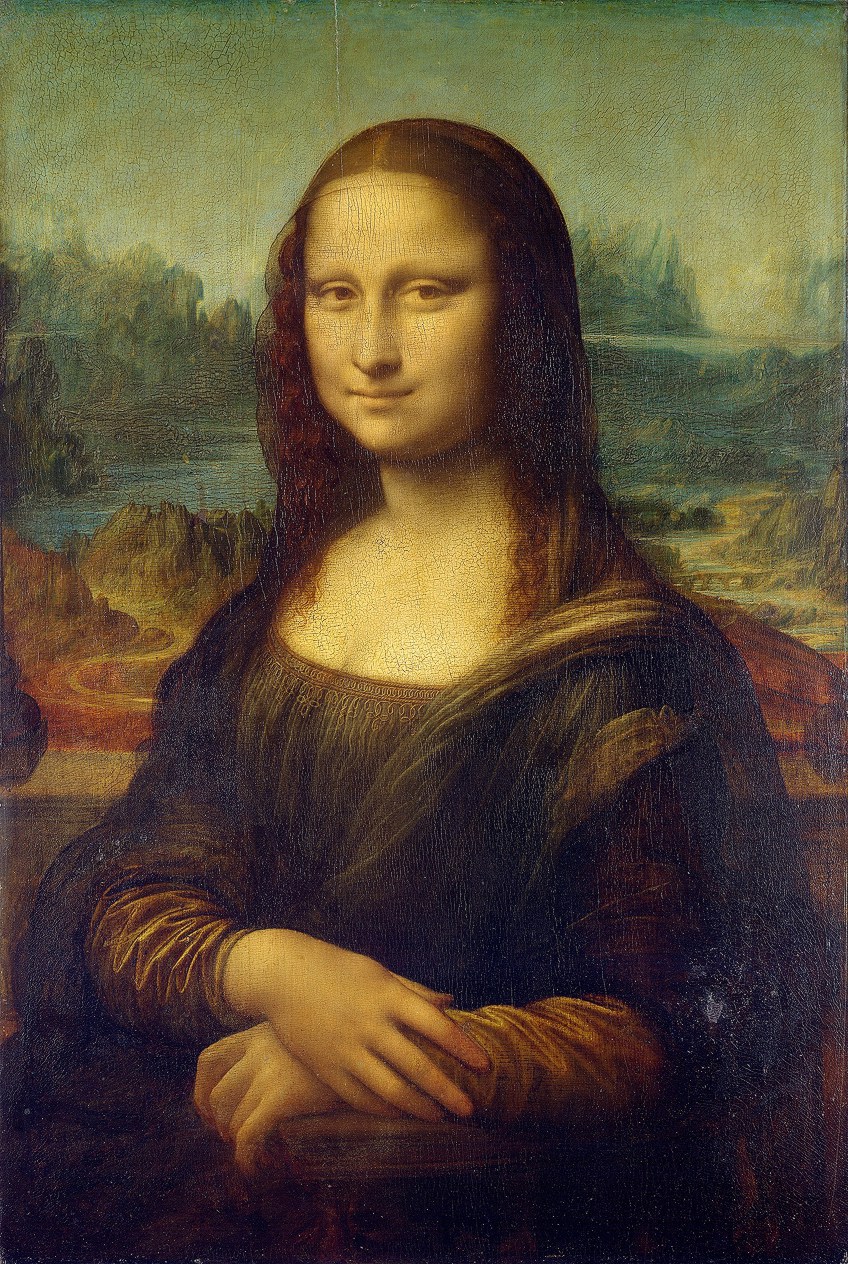
The great degree of realism of the woman’s hands, which look lifelike to the degree that they might almost be a photograph, is perhaps the most noticeable aspect of the Mona Lisa, at least among established painters who are well aware of the challenge in painting realistic images.
The Mona Lisa presently resides in the Louvre Museum in Paris, France, and attracts large crowds of art enthusiasts each year to see it in person.
Vertumnus (1590) by Arcimboldo
| Date Completed | 1590 |
| Medium | Oil Paint |
| Dimensions | 70 cm x 58 cm |
| Current Location | Skokloster Castle |
Arcimboldo is a painter whose style is tough to ignore. The Italian Renaissance artist is well-known for his portraits made of plants and vegetables. Each feature is represented by a distinct food or plant in the artist’s technique, which is infinitely detailed. Even the teeth stand out!
Despite the fact that this image is far from realistic, we must acknowledge Arcimboldo’s brilliance.

This is a technological accomplishment, using green beans for brows, scarlet fruits for lips, apples for cheekbones, and pears for the nose. Having said that, Arcimboldo nevertheless adheres to (most) of the criteria for traditional portraiture. The backdrop is a dark gray, and the subject’s head is angled three-quarters. This artwork was created as part of his Seasons series, which he began a few years prior to this work.
Vertumnus had the ability to alter his shape at whim, and he used it to woo Pomona, the deity of fertile plenty in old Roman mythology and folklore.
Las Meninas (1656) by Diego Velázquez
| Date Completed | 1656 |
| Medium | Oil on Canvas |
| Dimensions | 318 cm x 276 cm |
| Current Location | Museo Nacional del Prado |
The painting portrays a scenario from the royal family’s daily life, along with other figures who are all seen engaged in various acts, creating a sense of action and enthusiasm. The work exists as a brief look into the royal family’s existence that the outside populace would never have seen without the artist’s assistance.
In the shadowy recesses of the left side of the canvas, Velázquez includes himself into the picture as well, almost discretely gazing on in a beautiful, unobserved moment in the royal house.
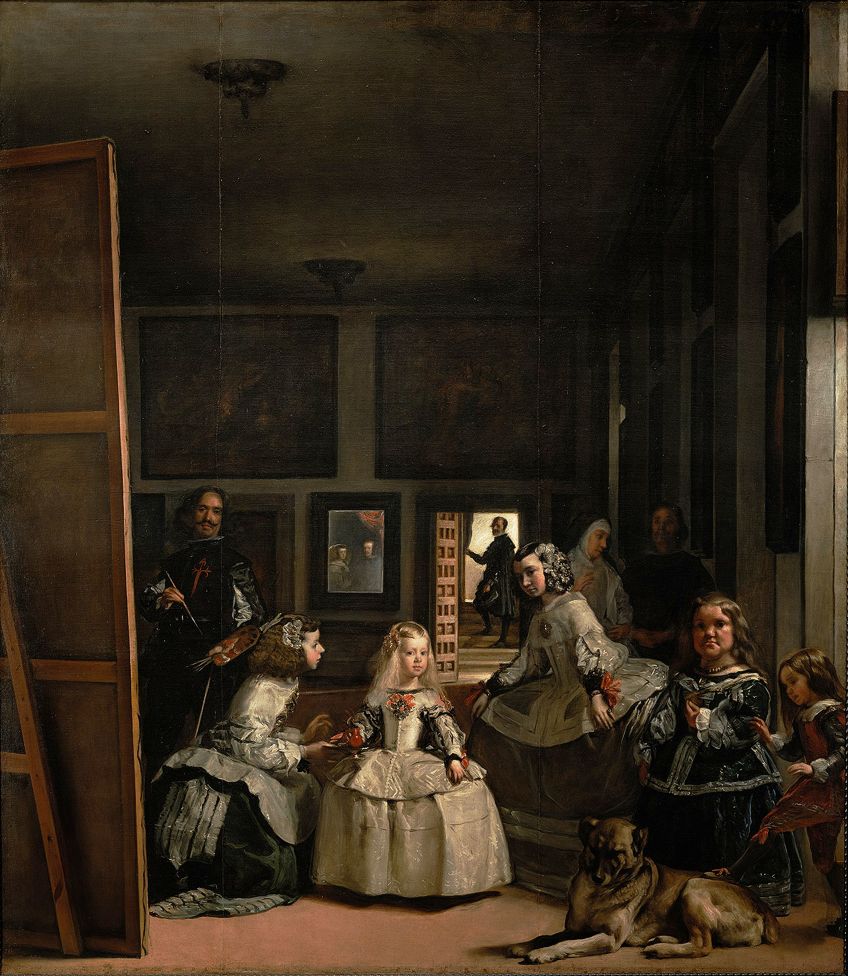
At the time of its completion, Diego Velázquez’ painting was regarded as one of the most brilliant works of art to emerge from 17th-century Spain. In Velázquez’ masterwork, Margarita Teresa, the famous five-year-old child of King Philip IV of Spain and Mariana of Austria, is portrayed.
The artwork features a magnificent degree of detail that provides insight into Velázquez and his goal to leave no aspect ignored over the entire canvas that measured a huge 10’5″ x 9’1″.
Girl with the Pearl Earring (1665) by Johannes Vermeer
| Date Completed | 1665 |
| Medium | Oil on Canvas |
| Dimensions | 44 cm x 39 cm |
| Current Location | Mauritshuis |
Johannes Vermeer was a well-known Dutch painter of the 17th century. He is well-known for his intimate domestic settings with stunning lighting. This is Vermeer’s most renowned work. It is not a portrait, but rather a “tronie” – a painting of a fictitious individual.
Tronies represent a certain type of character, in this example a female dressed in exotic attire, with an oriental turban and an unusually huge pearl in her ear.

The maestro of light was Johannes Vermeer. The smoothness of the girl’s face and the glints of light on her wet lips demonstrate this. And, of course, there’s the gleaming pearl. The oil painting depicts a young girl staring back at the spectator with a fascinating expression that piques the interest of those who have the pleasure of viewing this work.
The picture is well recognized for its incredible degree of realism and Vermeer’s ability to portray the tiny differences between light and shade.
Art experts and lovers agree that the girl’s gaze is one of the most engaging aspects of the piece since they are riveted on the observer in a humorous and anticipating manner. The girl’s attractiveness and characteristics are emphasized even more because the background around her appearance is a solid black void.
Self Portrait in a Straw Hat (1782) by Élisabeth Louise Vigée Le Brun
| Date Completed | 1782 |
| Medium | Oil Paint |
| Dimensions | 97 cm x 70 cm |
| Current Location | National Gallery, London |
She is dressed in a light pink gown, which was favored by Queen Marie Antoinette. It has white frills on the collar and white cuffs on the sleeves. As it curls around the elbows and descends her arm, a black cloth shawl stands out against the outfit. A straw hat sits on her head.
In principle, Élisabeth Louise Vigée Le Brun’s clothing is at the pinnacle of late-18th-century French design.
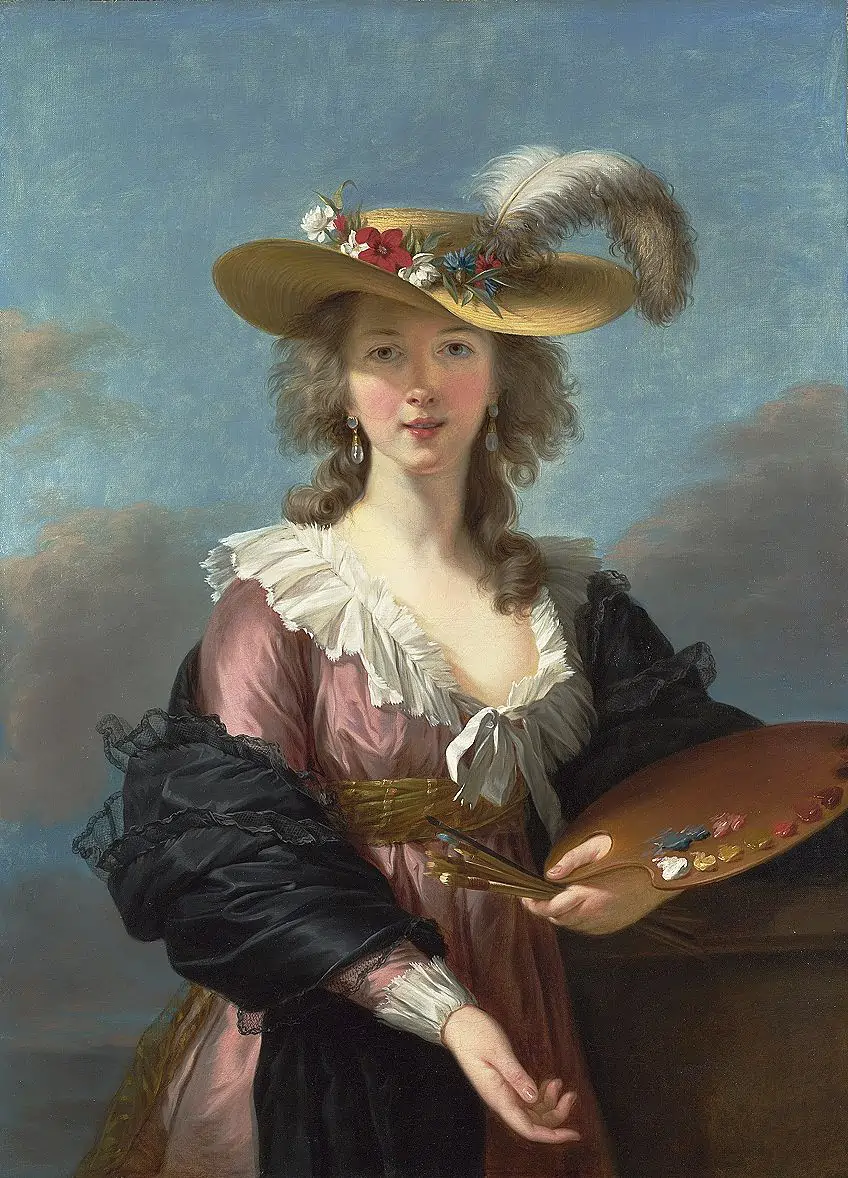
She is shown as a stylish aristocratic lady. Her costly jewelry and attire conceal her humble middle-class upbringing. The artist’s accessories appear to be almost instinctively in sync with Vigée Le Brun’s trendy outfit. The color on the palette accentuates the colors of her clothes, cap, and the sky beyond her. The paint colors are not by chance. Vigée Le Brun’s instruments are represented carefully and sensitively, proclaiming loudly, “I am a competent artist.”
Vigée Le Brun worked professionally as a painter for the upper crust of French aristocracy, where males and females alike wanted to be portrayed by her!
She was adept at merging aristocratic charm and middle-class morality in her representations. Her photos have no obnoxious immorality. They are modest and decent, yet they are also young and handsome. The physical beauty of the skin reflects the internal brilliance of the soul.
Portrait of Madame X (1884) by John Singer Sargent
| Date Completed | 1884 |
| Medium | Oil on Canvas |
| Dimensions | 235 cm x 110 cm |
| Current Location | Metropolitan Museum of Art |
John Singer Sargent is well known for his portraits of the affluent and aristocracy in both England and America (where he lived after 1886). Sargent’s portraits were unmistakably contemporary while being inspired by the Grand Manner style of intimidating and aristocratic portraiture loaded with virtue symbols.
Sargent picked stances that represented spontaneous, fluid moments captured in time rather than Neo-classical posturing or stylized rigidity.
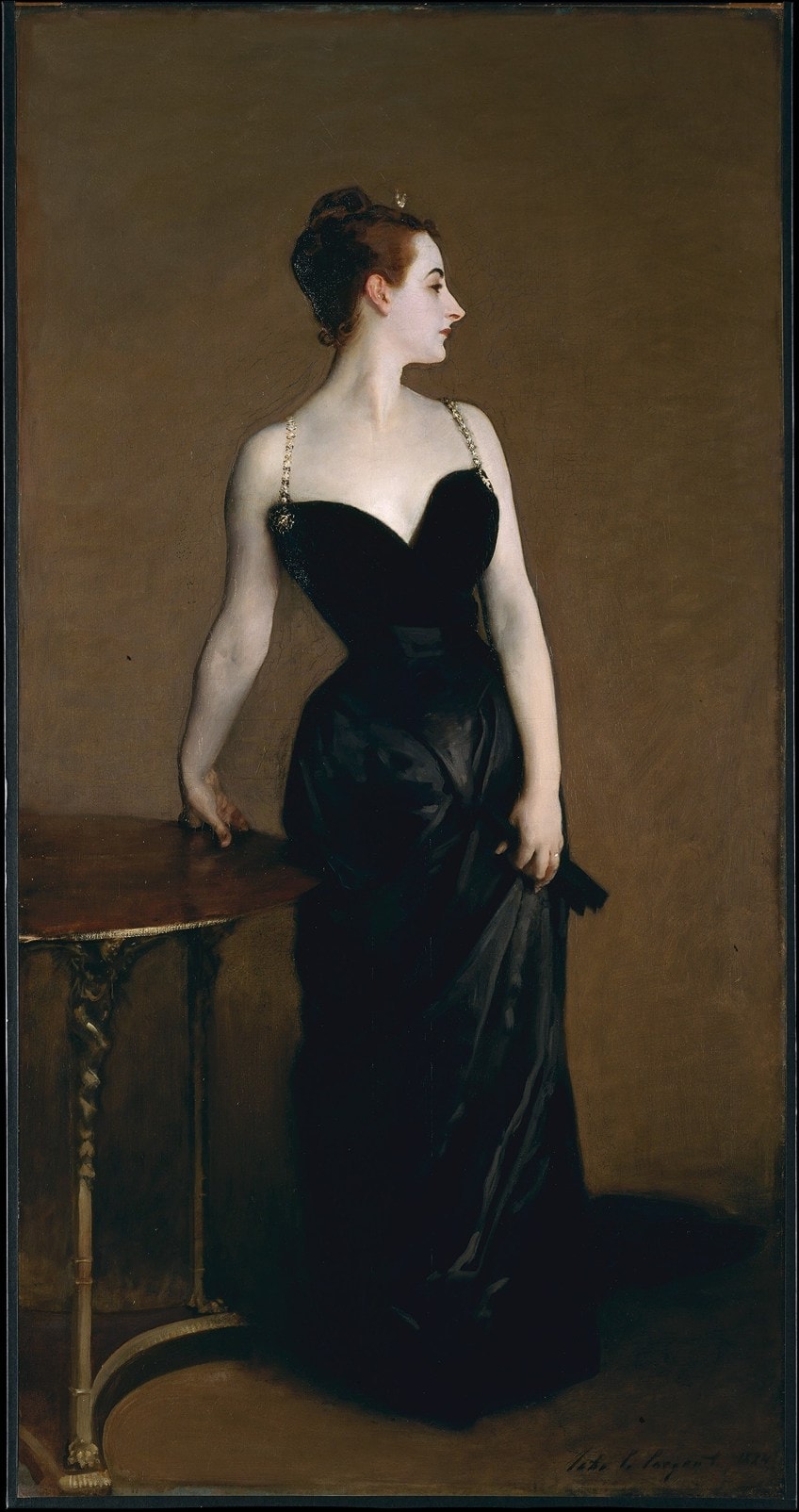
Madame X, his finest portraiture, showed Madame Virginie Amélie Avegno Gautreau, a stylish American belle who wedded a French banker and lived in Paris. While Gautreau was satisfied with the completed painting, the provocative clothes and carefree stance sparked controversy when it was shown at the Salon in Paris in 1884.
Sargent and the Salon attempted to conceal Gautreau’s identity, but it eventually became public knowledge, and both the painter and the subject were dissatisfied with the picture. Soon after, Sargent departed Paris for London.
Portrait of a Young Woman (1885) by Edgar Degas
| Date Completed | 1885 |
| Medium | Oil on Canvas |
| Dimensions | 27 cm x 22 cm |
| Current Location | Met Museum |
In art history, Impressionism and photographs are inextricably linked. Because of the introduction of photography, artists were freed from the constraint of portraying things “as they are” and began expressing an “impression” of how things seemed to them. Of course, this did not occur immediately. Although we have images dating back to 1826, photography was officially invented in 1839, and the impressionist genre flourished in the 1880s.
Edgar Degas was a well-known impressionist artist. His most renowned paintings are of ballerinas, which he initially photographed. According to the National Gallery of Art, his approach was significantly inspired by photography, as seen by “the individuals being chopped off and positioned off-center.
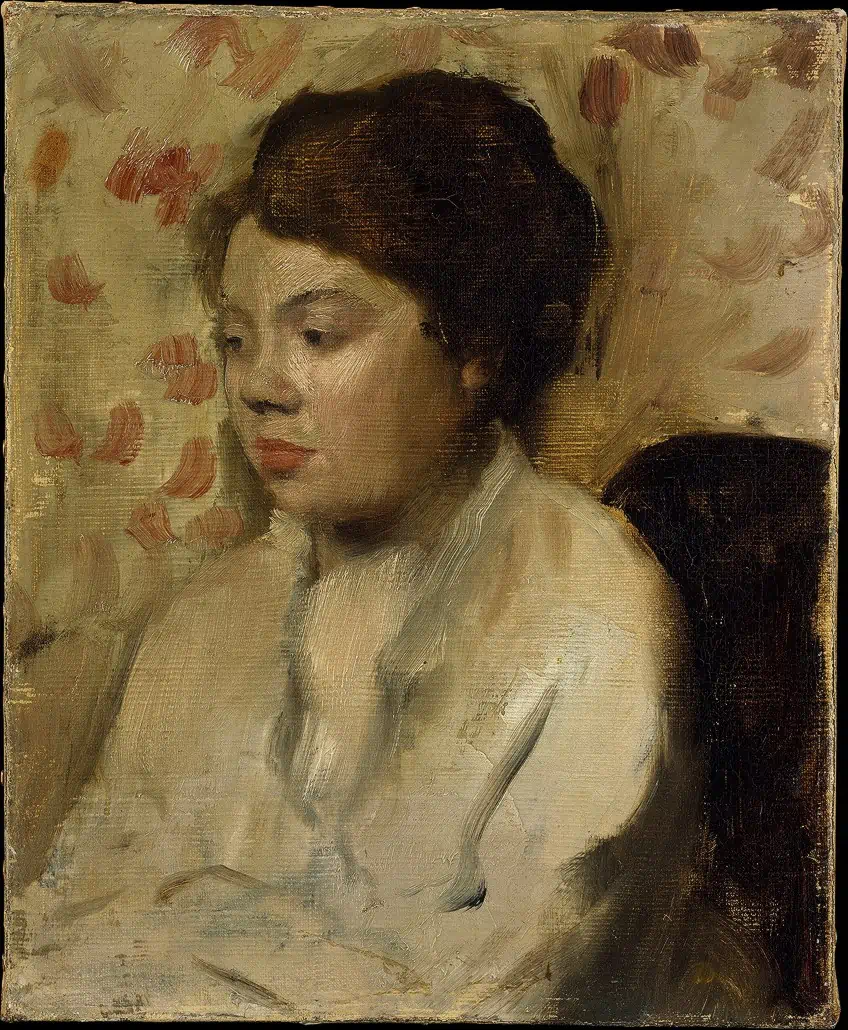
The sightlines are slanted and lofty.” Later in his career, Degas experimented with photography as an artistic medium. You can see how artwork and photography have enhanced each other over time – all of the great portraits in this book have impacted modern photographs.
Self-Portrait with Straw Hat (1887) by Vincent van Gogh
| Date Completed | 1887 |
| Medium | Oil on Canvas |
| Dimensions | 40 cm x 32 cm |
| Current Location | Met Museum |
The artist observes us with one green and one blue eye while dressed in light summer clothing. Van Gogh painted this self-portrait on cardboard, a less costly substitute for canvas. He then added a coat of primer with purple splatters.
However, the purple paint’s color has mainly faded over time. In his shoulders, a few faint pink strokes may still be seen. As a result, the original colors, which Van Gogh painstakingly crafted, have been gone.
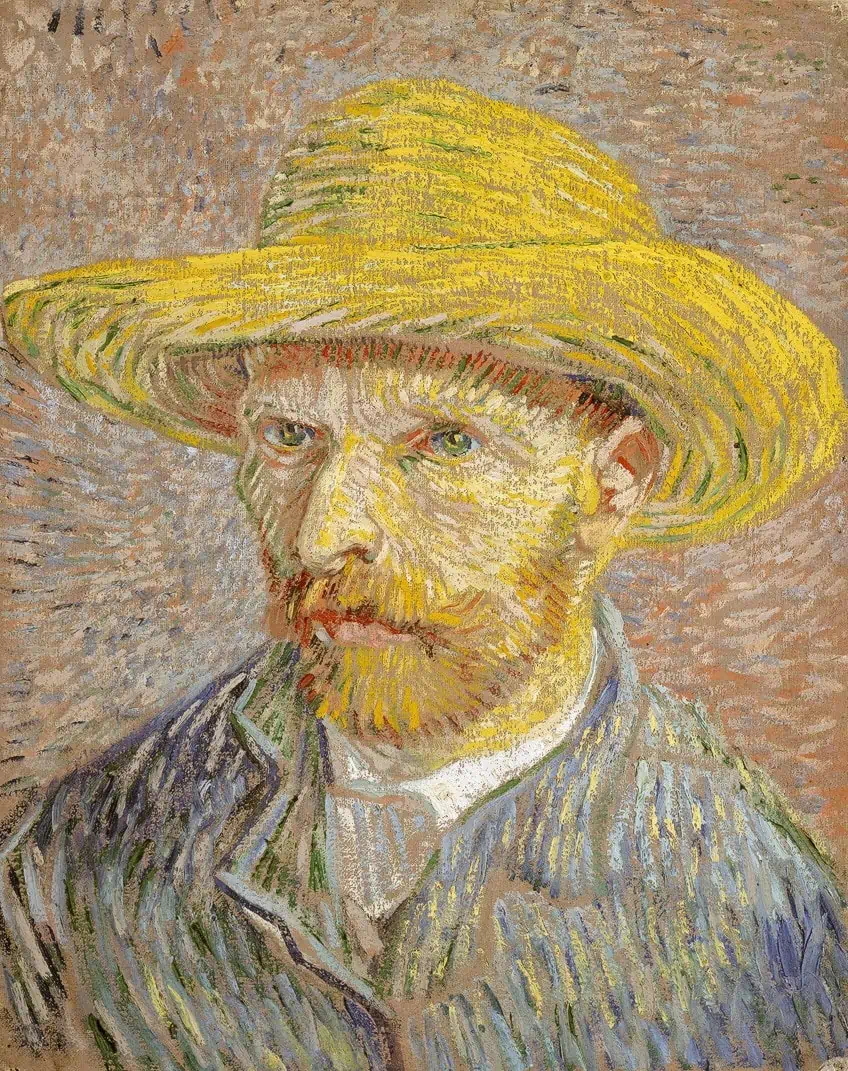
The purple background, for example, is used to contrast with his yellow-colored hat. Vincent Van Gogh produced at least 35 famous art portraits of himself – he used himself as a model for his paintings, and many of them became well-known portraits.
However, Van Gogh wasn’t only perfecting the mechanical aspects of portraiture when he painted self-portraits; he was also utilizing them as a method of self-understanding.
Woman with a Hat (1905) by Henri Matisse
| Date Completed | 1905 |
| Medium | Oil on Canvas |
| Dimensions | 81 cm x 60 cm |
| Current Location | San Francisco Museum of Modern Art |
This piece, which was initially shown at the Salon d’Automne in Paris in 1905, was at the core of the argument that led to the naming of the first contemporary art movement of the 20th century — Fauvism. An art critic created the word Fauve (“wild beast”) to describe the painters who displayed their vividly colored canvases in the Grand Palais’ central gallery.
It showed a stylistic shift from Matisse’s previous works of regimented brushstrokes to a more emotive unique style.
His utilization of non-naturalistic hues and looser brushstrokes, which led to a sketchy or “unfinished” aspect, struck observers as surprising at the time. Amélie, the creator’s wife, sat for this half-length picture. She is dressed elaborately, with characteristic French bourgeoisie traits such as a gloved arm clutching a fan and an ornate hat placed atop her head.
The rich colors of her attire, on the other hand, are entirely expressive. When questioned about the color of the garment Madame Matisse was donning when she sat for the image, the artist reputedly said, “Black, of course.”
Portrait of Gertrude Stein (1906) by Pablo Picasso
| Date Completed | 1906 |
| Medium | Oil on Canvas |
| Dimensions | 100 cm x 81 cm |
| Current Location | Metro Museum of Art |
Gertrude Stein, a famous art collector, and writer, was at the vanguard of Paris’ avant-garde in the early 20th century. She worked closely with significant modernist individuals, from pioneering authors like Ernest Hemingway and F. Scott Fitzgerald to avant-garde painters like Pablo Picasso and Henri Matisse, after migrating from Oakland, California to Paris in 1903.
Picasso credited Stein’s backing as a trigger for his early success, which he owed to her encouragement.
He produced a portrait of Stein in 1905 in his Rose Period style, which had a warm color palette and traces of “primitive” inspirations taken from Iberian art and masks from Africa. This painting, in addition to capturing the major aspects of this significant moment, portrays his sitter’s self-assured manner and self-made status, much to Stein’s delight.
“I was and still am delighted with my portrait because it is me, and it is the one representation of me that is always me, for me,” Stein comments on the work in Picasso, her book.
Portrait of Adele Bloch-Bauer I (1907) by Gustav Klimt
| Date Completed | 1907 |
| Medium | Gold and Oil on Canvas |
| Dimensions | 138 cm x 138 cm |
| Current Location | Neue Galerie, New York |
Few famous portraits among the most renowned paintings of all time have as many flamboyant colors and iconography as Gustav Klimt’s. The painting was finished in 1907 and depicts the spouse of Ferdinand Bloch-Bauer, a renowned industrialist in early 20th century Austria.
The artwork was also dubbed as The Woman of Gold because of its high degree of gold tones throughout the picture, which many art fans and critics find overpowering.
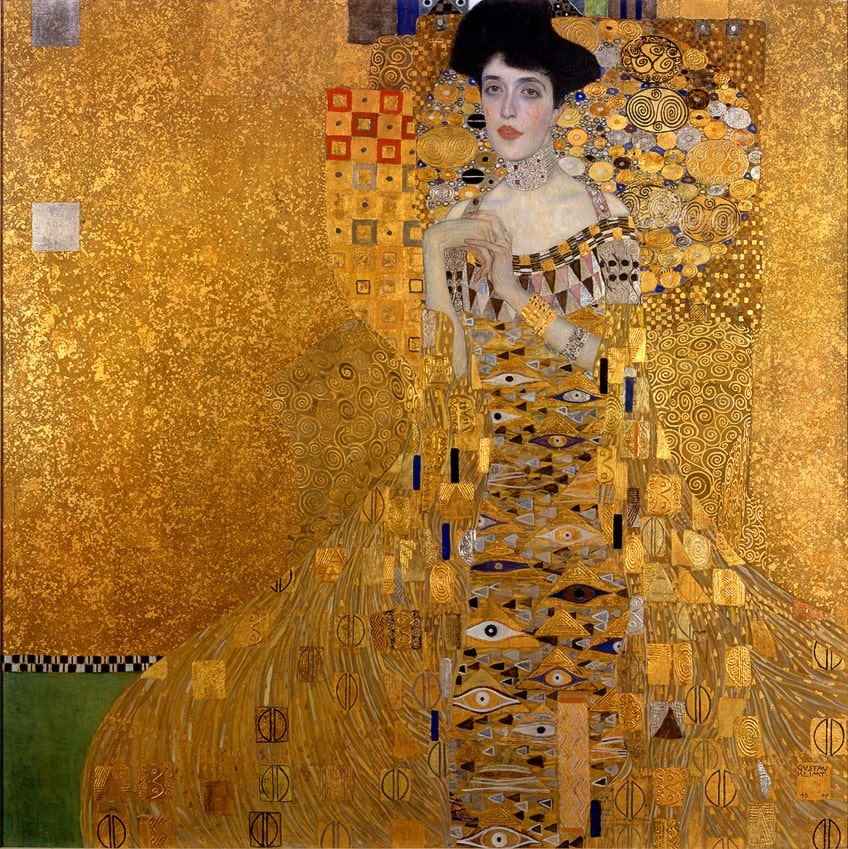
The piece depicts a wide range of distinct ways in which light interacts with the surface of gold, with its many glints and flashes. After being taken by the Germans during World War II, this piece received more recognition and infamy.
Years later, Adele’s family went to court to reclaim ownership of the artwork from the Austrian government.
Portrait of Pablo Picasso (1912) by Juan Gris
| Date Completed | 1912 |
| Medium | Oil Paint |
| Dimensions | 93 cm x 74 cm |
| Current Location | School of the Art Institute of Chicago |
Gris greatly admired Picasso. His image of Picasso (the originator of Cubism) in the Cubist technique exists as a smart homage to his source of inspiration. Picasso is truly larger than life, with a palette at the ready and taking up most of the space on the painting.
He splits the sitter’s visage into a prism of surfaces and geometric forms that merge into the rows in the backdrop, making use of mainly cool gray, blue, and brown tones.
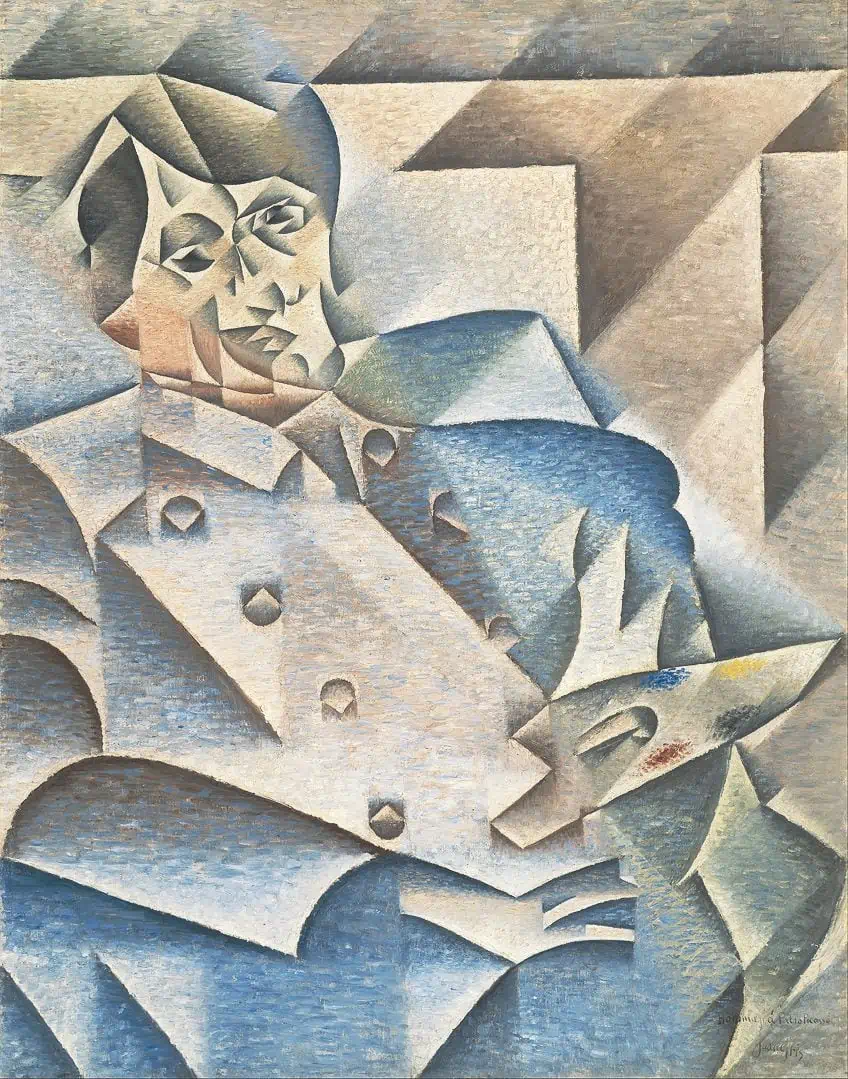
All of the elements in this image appear to be in action. While he and his colleagues created many more chaotic photos, characteristics of formal portraits, such as the coherence of the sitter’s characteristics, symmetry of the posture, and high-collared garments (as compared to an artist’s apron), show his regard for the subject. However, in its departure from traditional depiction and its attempt to convey the dynamic of current life, it is perfectly consistent with the Cubist objective.
The subtle geometric forms in the painting draw attention to the numerous degrees of light, and how the darkness dissolves into other sections to create a calm image of the great Picasso.
American Gothic (1930) by Grant Wood
| Date Completed | 1930 |
| Medium | Oil on Beaverboard |
| Dimensions | 78 cm x 65 cm |
| Current Location | Royal Academy of Arts |
Even though numerous observers believe that the somber-looking gentleman and lady are modeled after a real-life farmer and his spouse, the classic picture is really a portrait of the artist’s younger sibling, Nan Wood Graham, and their family dentist, Dr. Byron McKeeby. While Wood wanted the pair to depict a parent and his child, he left the conclusion up to the audience.
“Of course, these specifics aren’t really important,” Wood remarked in a 1941 letter, “what matters is if these looks are representative of contemporary American society and tell anything about it.”
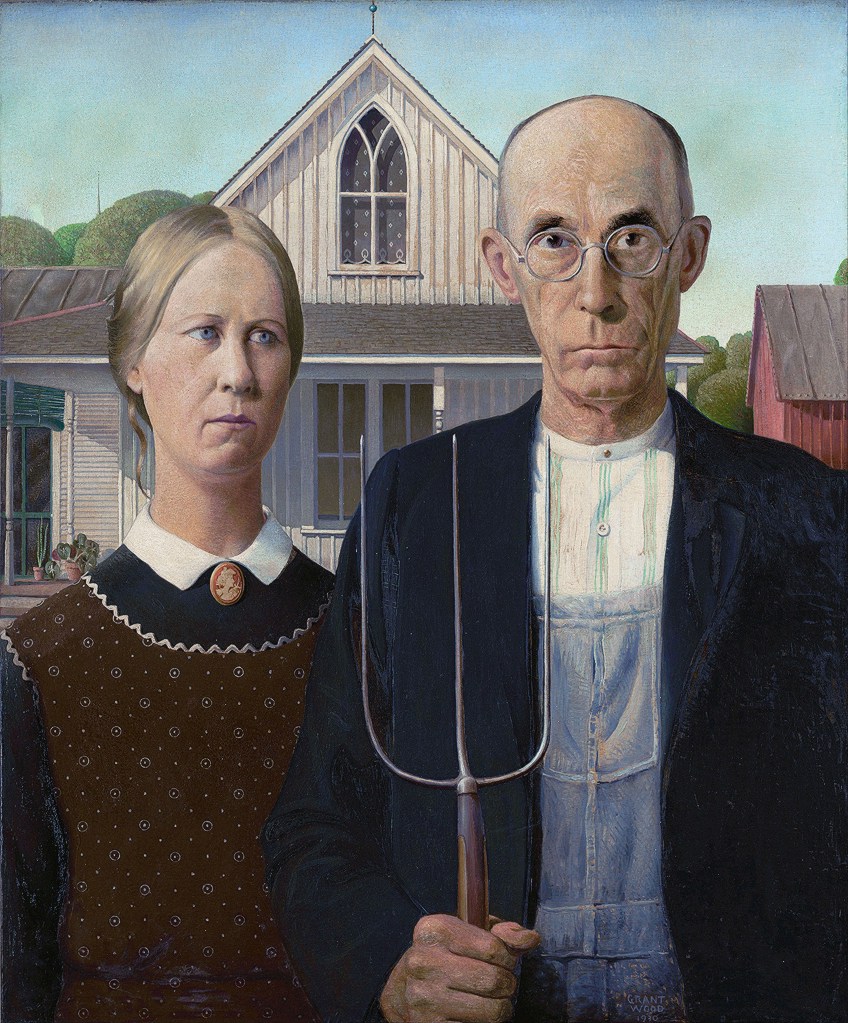
The picture, painted in 1930, serves as a vivid reminder of the sufferings endured by Americans during the Great Depression of the 1920s. It is an excellent example of Social Realism art. According to Wood, his image represents a distinctively designed mansion with a Gothic-style architectural aspect. The work shows the hardworking American character in which the country takes great pleasure.
Wood’s painting quickly became a classic and one of the most iconic pieces of art in American culture.
The Two Fridas (1939) by Frida Kahlo
| Date Completed | 1939 |
| Medium | Oil on Canvas |
| Dimensions | 174 cm x 173 cm |
| Current Location | Museo de Arte Moderno, Mexico City |
Frida Kahlo, a renowned Mexican painter, is known for her paintings that reflect the spirit of the country’s indigenous history, as well as the expanding European influence of the early 1900s. The Two Fridas is a strange yet thought-provoking picture of the dual structure of the society in which she and other Mexicans live at the time.
The picture was completed in 1939 and depicts two versions of Kahlo reclining in an exquisite yet puzzling manner.
On the left, viewers see a portrayal of Kahlo wearing a European-style outfit that was popular among upper-class Mexicans at the time, which also functioned as a symbol of luxury and richness. The Kahlo on the right is dressed in much more conventional Mexican clothing that has a lot more color than the other’s dazzling white attire.
According to the artist, the image depicts a country split apart by the oncoming European influences of the day but still adhering to the spirit of Mexican tradition. We can easily identify where Kahlo’s heart is since her European-dressed counterpart has a bursting heart, but the Frida on the right has a heart that is living and thriving.
Marilyn Monroe (1967) by Andy Warhol
| Date Completed | 1967 |
| Medium | Silkscreen Print |
| Dimensions | 91 cm x 91 cm |
| Current Location | Museum of Modern Art |
These famous portraits have traveled the world! Warhol recognized Marilyn Monroe as an endless source of inspiration and reproduced her picture in a series of colorful silkscreen prints. Warhol, a significant figure in the Pop Art movement, echoed the outrage of the American people when the singer and performer was discovered to have committed suicide in 1962.
These images were motivated by a shot from a film advertisement for Niagara, in which Monroe appears in monochrome with a fixed grin.
Warhol colors her face and exaggerates her cosmetics in his silkscreen prints. Furthermore, the color of her eyelashes methodically mimics the color of the background. It can appear like an actual portrayal of her at times, yet her ultra-bright colors might be a tad hard on the eyes in other instances.
This odd juxtaposition was Warhol’s way of paying tribute to the icon’s mesmerizing existence in Hollywood during the 1950s and 1960s.
Each picture was produced from five screens: one with the photographic image and four with varying sections of color, some of which were printed off-register. “The more you stare at the same precise item, the more the significance melts away, and the finer and emptier you get,” Warhol stated repeatedly.
Despite the contemporary art world producing several new styles and genres in art, portrait painting still exists as one of the most loved, and most difficult, types of painting. Portrait painting has such a high level of finesse that artists have been able to capture realistic portrayals, along with spiritual and intellectual aspects of their sitters, all in one artwork. While we have only covered 16 of the most famous art portraits ever made, many other equally iconic works exist for you to explore. If you have enjoyed our article, we encourage you to read up about these other works!
Take a look at our portrait paintings webstory here!
Frequently Asked Questions
Who Produced the World’s Most Famous Art Portraits?
Portraits have always been a very popular type of subject matter. In fact, many famous artists, if not most, have all tried their hand at creating portraiture at some point in their careers. While many were indeed life-like, others explored how the sitter made them feel or what kind of energy they portrayed to the artist.
Why Did Artists Create Famous Art Portraits?
Portraiture painting is widely considered to be the most difficult type of painting since it requires a deep grasp of representing the human figure in minute detail. Portraits concentrate on one or more persons, with the top half of the body receiving the greatest attention. Some of history’s greatest famous artists have captured the essence of human feeling in a single picture. Many artists have studied human anatomy in depth in order to comprehend the complexity of each slight shift in emotion. Famous portrait artists from all around the world, such as Rembrandt and Leonardo da Vinci, spent years honing their painting talents in order to master the art of portraiture.
Liam Davis is an experienced art historian with demonstrated experience in the industry. After graduating from the Academy of Art History with a bachelor’s degree, Liam worked for many years as a copywriter for various art magazines and online art galleries. He also worked as an art curator for an art gallery in Illinois before working now as editor-in-chief for artfilemagazine.com. Liam’s passion is, aside from sculptures from the Roman and Greek periods, cave paintings, and neolithic art.
Learn more about Liam Davis and about us.
Cite this Article
Liam, Davis, “Famous Portrait Paintings – A Look at the Most Famous Art Portraits.” artfilemagazine – Your Online Art Source. February 22, 2022. URL: https://artfilemagazine.com/famous-portrait-paintings/
Davis, L. (2022, 22 February). Famous Portrait Paintings – A Look at the Most Famous Art Portraits. artfilemagazine – Your Online Art Source. https://artfilemagazine.com/famous-portrait-paintings/
Davis, Liam. “Famous Portrait Paintings – A Look at the Most Famous Art Portraits.” artfilemagazine – Your Online Art Source, February 22, 2022. https://artfilemagazine.com/famous-portrait-paintings/.


